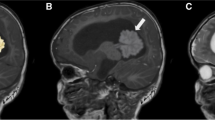Abstract
Kaposiform haemangioendothelioma (KHE) is a rare childhood disease classified by the International Society for the Study of Vascular Anomalies (ISSVA) as a locally aggressive vascular tumor. It has been reported to affect any site, with a predilection for the extremities and trunk. Although it typically manifests as an enlarging cutaneous or soft tissue lesion, less than 10% of cases have no skin involvement, with the retroperitoneum being the most frequently involved extracutaneous site. Approximately twenty cases of KHE with bony involvement have been reported in the literature to date, with only five of those cases involving the spine specifically.
We present a, rare case of KHE who presented with progressive fixed hyperlordotic deformity, multiple non-specific spinal lesions, and abnormal blood tests, posing a clinical and radiological diagnostic challenge. Additionally, we conducted a thorough review of the literature to compare and contrast the various multimodality imaging manifestations of KHE involving the spine.





Similar content being viewed by others
References
Zukerberg LR, Nickoloff BJ, Weiss SW. Kaposiform hemangioendothelioma of infancy and childhood An aggressive neoplasm associated with Kasabach-Merritt syndrome and lymphangiomatosis Am. J Surg Pathol. 1993;17(4):321–8.
Croteau SE, Liang MG, Kozakewich HP, et al. Kaposiform hemangioendothelioma: atypical features and risks of Kasabach-Merritt phenomenon in 107 referrals. J Pediatr. 2013;162(1):142–7.
Schmid I, Klenk AK, Sparber-Sauer M, Koscielniak E, Maxwell R, Häberle B. Kaposiform hemangioendothelioma in children: a benign vascular tumor with multiple treatment options. World J Pediatr. 2018;14(4):322–9.
International Society for the Study of Vascular Anomalies. ISSVA classification of vascular anomalies ©2014. 2017. Available from: issva.org/classification
Niedt GW, Greco MA, Wieczorek R, Blanc WA, Knowles DM. Hemangioma with Kaposi’s sarcoma-like features: report of two cases. Pediatr Pathol. 1989;9(5):567–75.
Hu P, Zhou Z. Clinical and imaging features of Kaposiform Hemangioendothelioma. Br J Radiol. 2018;91(1086).
Liu Q, Jiang L, Wu D, et al. Clinicopathological features of kaposiform hemangioendothelioma. Int J Clin Exp Pathol. 2015;8(10):13711–8.
Ji Y, Chen S, Yang K, Xia C, Li L. Kaposiform hemangioendothelioma: current knowledge and future perspectives. Orphanet J Rare Dis. 2020;15(1):39.
Kasabach HH, Merritt KK. Capillary hemangioma with extensive purpura: report of a case. Am J Dis Child. 1940;59(5):1063–70.
Sarkar M, Mulliken JB, Kozakewich HP, Robertson RL, Burrows PE. Thrombocytopenic coagulopathy (Kasabach-Merritt phenomenon) is associated with Kaposiform hemangioendothelioma and not with common infantile hemangioma. Plast Reconstr Surg. 1997;100(6):1377–86.
Enjolras O, Wassef M, Mazoyer E, et al. Infants with Kasabach-Merritt syndrome do not have “true” hemangiomas. J Pediatr. 1997;130(4):631–40.
Eseonu K, Anwar H. Kaposiform hemangioendothelioma in the thoracic spine: a case report and review of the literature. Int J Spine Surg. 2020;14(3):426–32.
Ryu YJ, Choi YH, Cheon J-E, et al. Imaging findings of Kaposiform Hemangioendothelioma in children. Eur J Radiol. 2017;86:198–205.
Ji Y, Chen S, Peng S, Xia C, Li L. Kaposiform lymphangiomatosis and kaposiform hemangioendothelioma: similarities and differences. Orphanet J Rare Dis. 2019;14:165.
Lyons LL, North PE, Mac-Moune Lai F, Stoler MH, Folpe AL, Weiss SW. Kaposiform hemangioendothelioma: a study of 33 cases emphasizing its pathologic, immunophenotypic, and biologic uniqueness from juvenile hemangioma. Am J Surg Pathol. 2004;28(5):559–68.
Glaser K, Dickie P, Dickie BH. Proliferative cells from kaposiform lymphangiomatosis lesions resemble mesenchyme stem cell-like pericytes defective in vessel formation. J Pediatr Hematol Oncol. 2018;40(8):e495–504.
Goyal P, Alomari AI, Kozakewich HP, et al. Imaging features of kaposiform lymphangiomatosis. Pediatr Radiol. 2016;46(9):1282–90.
Drolet BA, Trenor CC, Brandão LR, et al. Consensus-derived practice standards plan for complicated Kaposiform hemangioendothelioma. J Pediatr. 2013;163(1):285–91.
Wiseman AC. Immunosuppressive Medications. Clin J Am Soc Nephrol. 2016;11(2):332–43.
Lisle JW, Bradeen HA, Kalof AN. Kaposiform hemangioendothelioma in multiple spinal levels without skin changes. Clin Orthop Relat Res. 2009;467(9):2464–71.
Zhu Y, Qiu G, Zhao H, Liang J, Shi X. Kaposiform hemangioendothelioma with adolescent thoracic scoliosis: a case report and review of literature. Eur Spine J. 2011;20(Suppl 2):S309-313.
Liu F-S, Zou M-X, Zheng B-W, Wang X-B, Lyu G-H, Li J. A report on Kaposiform hemangioendothelioma in the cervical spine. Chin Med J (Engl). 2019;132(11):1378–80.
Kim J, Kim YH, Kim H, Chang B-S, Lee C-K, Chang SY. Kaposiform Hemangioendothelioma in adolescent-onset scoliosis: a case report and review of literature. Case Rep Orthop. 2020;2020:1839053.
Acknowledgements
Elaine Y.L. Kan, MBChB, FRCR, FHKCR, FHKAM (Radiology) for supportive insights and comments that greatly improved the manuscript.
Author information
Authors and Affiliations
Corresponding author
Ethics declarations
Ethics approval and consent to participate
This article does not contain any studies with human participants or animals performed by any of the authors. Statement of informed consent was not applicable since the manuscript does not contain any patient data.
Conflict of interest
The authors declare no competing interests.
Additional information
Publisher's note
Springer Nature remains neutral with regard to jurisdictional claims in published maps and institutional affiliations.
Rights and permissions
Springer Nature or its licensor holds exclusive rights to this article under a publishing agreement with the author(s) or other rightsholder(s); author self-archiving of the accepted manuscript version of this article is solely governed by the terms of such publishing agreement and applicable law.
About this article
Cite this article
Chin, L.H.Q., Fung, K.K.F., Chan, J.P.K. et al. Kaposiform haemangioendothelioma of the spine associated with fixed hyperlordotic deformity and Kasabach–Merritt Syndrome: a case report and literature review. Skeletal Radiol 52, 783–790 (2023). https://doi.org/10.1007/s00256-022-04152-z
Received:
Revised:
Accepted:
Published:
Issue Date:
DOI: https://doi.org/10.1007/s00256-022-04152-z




